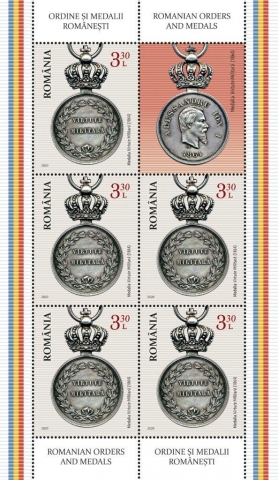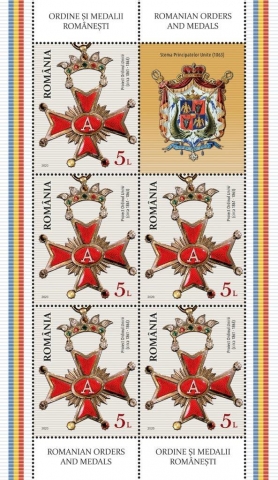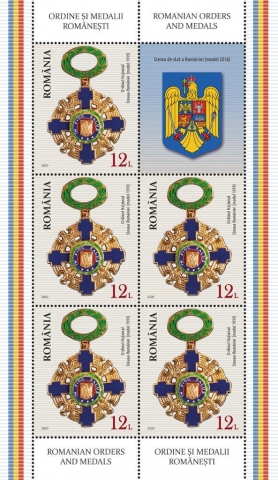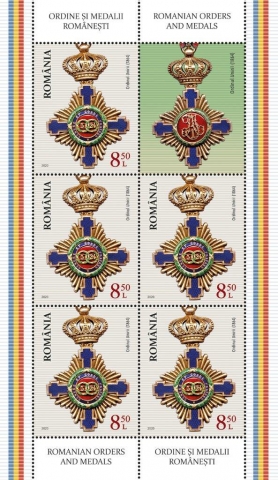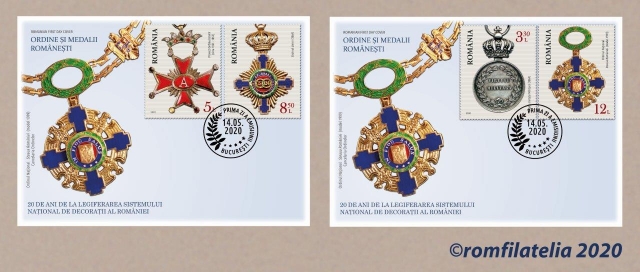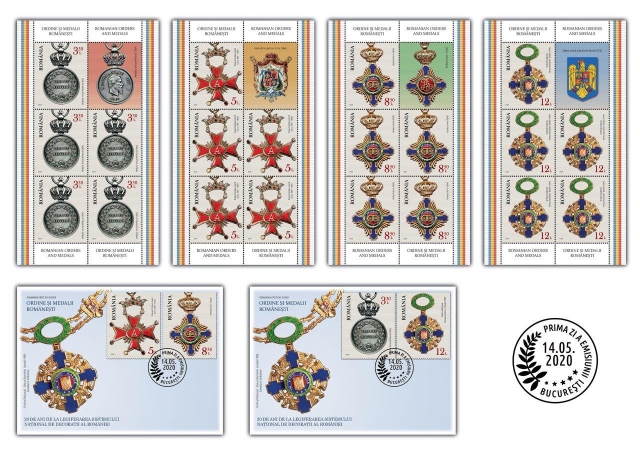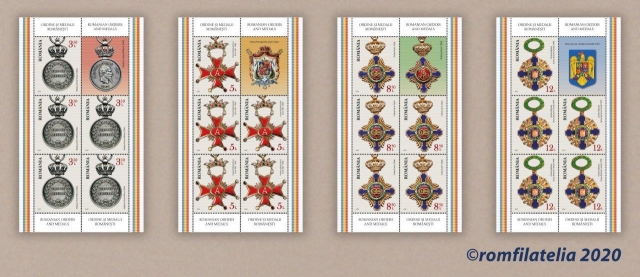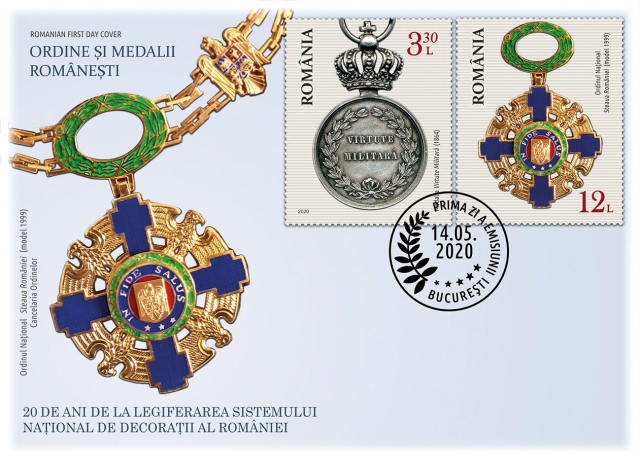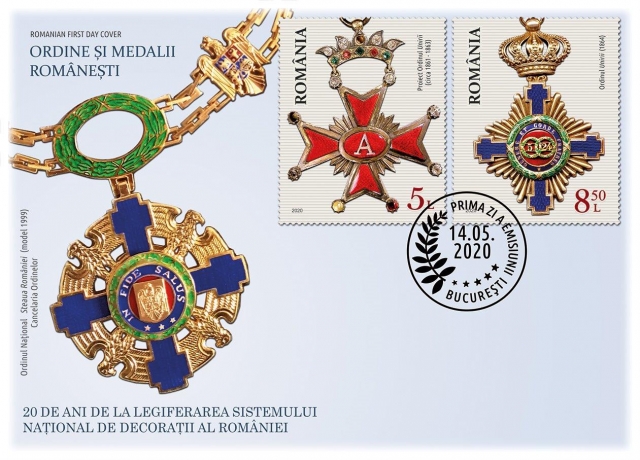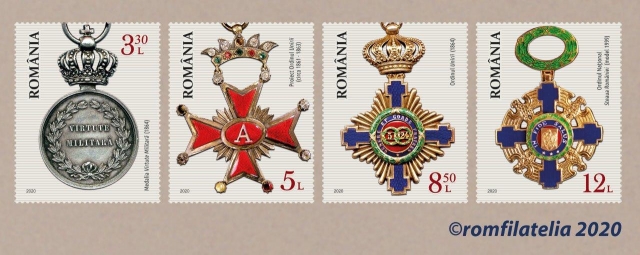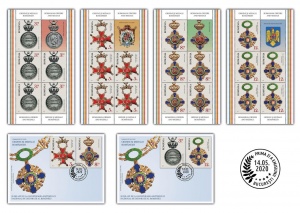 Continuing the series of the topics dedicated to Orders and Medalistics, Romfilatelia introduces into circulation on Thursday, May 14th, 2020 the postage stamps issue entitled Romanian Orders and Medals.
Continuing the series of the topics dedicated to Orders and Medalistics, Romfilatelia introduces into circulation on Thursday, May 14th, 2020 the postage stamps issue entitled Romanian Orders and Medals.
The issue, made up of four postage stamps, also marks the 20th Anniversary of the Enactment of the National Decoration System of Romania.
On the stamp with the face value of Lei 3.30, it was illustrated the Military Virtue Medal (1864).
The MILITARY VIRTUE Medal, established, probably, in 1864, to be distributed on the 5th anniversary of the Union (January 24th, 1864), or to be awarded to the military participating in limiting the effects of the floods in Bucharest, of that year; it was made of silver, with a diameter of 30 mm; above the insignia, there is a 19 mm princely crown and a ribbon ring-shaped fastener; on the obverse there is a garland of bay leaves (laurel), which surrounds the MILITARY VIRTUE inscription, on two rows; on the reverse there is the effigy of the ruler, from the right profile, having written the text ALESSANDRU ION I above the head, on a circular contour, and below, in the middle, the year 1864; the insignia bears, under the effigy, the small initials of the engraver Caque F.; the ribbon is red with a blue stripe on the edge.
The decoration, whose image has been reproduced, is part of the collection of the King Ferdinand I National Military Museum.
On the next two stamps, with the face values of Lei 5.00, respectively, Lei 8.50 the Project Order of the Union (around 1861 – 1863), respectively, the Order of the Union (1864) were reproduced.
Prince Alexandru Ioan I (Cuza) tried from the first years of his reign to impose on the Ottoman Empire the acceptance of the right to establish decorations. In a desire to implement a strategy aimed at gradually achieving the country’s full autonomy, Prince Cuza considered that there was no treaty text expressly mentioning the ban on the establishment of a reward system and generally relied on the tactic of confronting suzerain power with a fait accomplished.
As early as 1859, the prince thought of establishing a Romanian National Order, following the example of the “Legion of Honour” in France. The Minister of Romania in Paris, Vasile Alecsandri, taking advantage of the good relations he had at the Court of France, asked the permission of Emperor Napoleon III, so that the French officials could be rewarded and could bear the future Romanian Order.
The proposal was accepted by the emperor who, at the moment, did not realize that, according to the rules of international law, the Principalities could not establish an honorary system, because they were under Ottoman suzerainty.
Returning to the country, Alecsandri proposed the creation of the Order of the Golden Wreath, which was to reward Romanians and foreigners who had served the United Principalities.
The order was to have both a civilian and a military component.
Obverse: it had to have the “ONORE PATRIA” motto inscribed on it;
Reverse: the legend “IN UNA OMNIA”.
Ribbon: it was to be made of blue tabby, bordered with yellow.
The Central Commission changed the name of the Order the Cross of the Union or, in short, the Order of the Union. It was divided into five classes, consisting of 1,000 members (750 Knights, 150 Officers, 60 Commanders, 28 Grand Officers and 12 Grand Crosses). The ranks of Grand Officer and Grand Cross also had a plaque, worn on the right chest.
Meeting with the categorical opposition of the Ottoman Empire, as well as of the Austrian Empire – who saw in this undertaking a clear sign of assertion of sovereignty – in order not to jeopardize Cuza’s double election, the project was not implemented then, being postponed. A first representation of the new order can be seen on the draft of the coat of arms of the Principalities drawn by the painter Carol Popp of Szathmary, in 1863.
In 1864, the ruler asked the representative of Romania in Paris, Vasile Alecsandri, to contact a well-known jewellery house, in order to make the decorations. The Krétly House in Paris presented a design that was immediately accepted by the ruler and, based on his agreement, an order for the 1,000 counterparts of the order was placed. The design proposed by the Krétly House was a repeated cross, enamelled in blue – a shape that, at that time, was almost not used in phaleristics.
Obverse: between two laurel wreaths, the numbers 5 and 24 – the data of the double election of Alexandru Ioan Cuza as ruler in the two Romanian Principalities, and on the border the motto “GENERE ET CORDE FRATRES” (“BROTHERS OF ORIGINS AND HEART”).
Reverse: the ruler’s code in the “AI 1” ligature.
Ribbon: made of blue tabby bordered with the country’s tricolour.
The decoration was to have three classes – Knight, Officer, Commander.
It seems that the order was also worked in the country by two decorations and jewellery houses, the Resch House and the Fain House. Unable to establish and grant the order because of the status of State vassal to the Ottoman Empire, Cuza granted it, personally, only to a few immediate acquaintances. This order was used as a model of inspiration for the first official distinction granted by the Romanian State, the Star of Romania National Order, established on May 9th, 1877. This order is among the few distinctions (along with the Sanitary Merit Cross and the Cultural Merit and Agricultural Merit orders), which will be found, with a different shape, in the Romanian honorary systems after 1948 and 1989.
The National History Museum of Romania has the draft of the so-called Order of the Union, 2nd design, which belonged to the painter Carol Popp of Szathmari.
The stamp with the value of Lei 12.00 shows the image of the Star of Romania National Order (model 1999).
The Star of Romania National Order it is the highest order that was reinstated in 1998. By granting this order, the exceptional civilian and military services brought to the Romanian State are rewarded.
It is conferred for special deeds committed in time of peace or for acts of heroism in time of war.
The grade of Collar is composed of an 840 mm long chain and the insignia of the grade. The chain includes six cartridges, representing each the impressed coat of arms of Romania and six insignia of the order, enamelled in blue, fastened together by double chains, with square links. The impressed coat of arms of Romania is 25 mm high, and the cross of the order is 25 mm in diameter. The lock of the Collar consists of a carbine, made up of two halves of eagle with wide open wings.
The insignia of the grade is identical with the insignia of the grade of the Grand Cross. The design for women is identical. There are no different designs of the order awarded to civilian, military personnel and for brave acts of war.
The metal from which the Collar grade is made is 900‰ silver and is gilded.
The necklace is worn around the neck, above the clothing.
The image of obverse of the Star of Romania National Order, also illustrated on the First Day Cover, was made available by the Chancellery of Orders within the Presidential Administration.
Romfilatelia thanks the Chancellery of Orders within the Presidential Administration, the National History Museum of Romania, Professor Corneliu Andonie within the “King Ferdinand I” National Military Museum and the Romanian Academy Library for the documentary and photographic support granted to the achievement of this postage stamps issue.
The postage stamps issue “Romanian Orders and Medals” will be available on Thursday May 14th 2020, in Romfilatelia’s shops network in Bucharest, Bacau, Brasov, Cluj-Napoca, Iasi and Timisoara and online on https://romfilatelia.ro/store/. The postage stamps issue is completed by 2 “first day” covers, in sheet of 20 stamps and minisheet of 5 stamps + 1 label.
For further information, please contact the Public Relation Office:
Tel: 021 / 336 93 92



